Ginger Farming Guide:
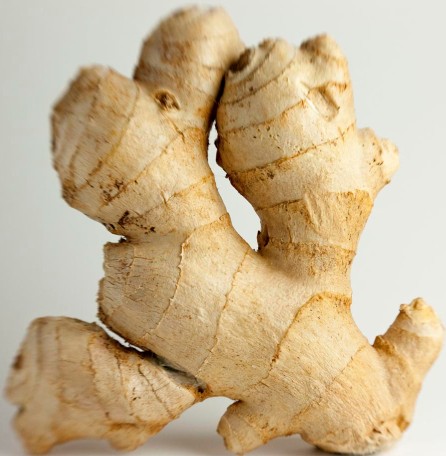
Introduction of Ginger Farming:- Ginger is one of excellent spice crops cultivated in Asia and India accounts for 40 % of the world’s ginger production. Ginger root has high demand in national and international markets due to its excellent uses and benefits. Farmers can make gold out of it, if they follow the proper farm management practices. Ginger can be grown in greenhouse, indoors, containers, pots, and backyards. When it comes to plant description, ginger is an herbaceous perennial plant that grows annual stems about 1 meter tall bearing narrow green leaves and yellow flowers. Ginger belongs to the family of “Zingiberaceae” and genus of “Zingiber”. Basically ginger is indigenous to south China and eventually spread across the globe. India is largest producer and consumer of ginger in the world and China occupies second place. Ginger is being used as a spice in many food items as well as in herbal medicines due to its excellent medicinal properties. Ginger also being used as flavouring agent because of its unique refreshing aroma. Commercial cultivation of ginger is very successful in most of the south Asia regions due its market value.
Health Benefits of Ginger:-The following are the health benefits of Ginger.
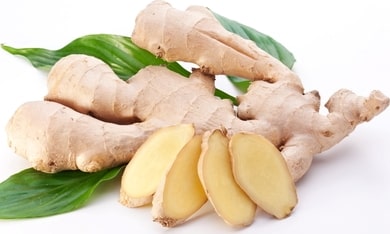
- Ginger promotes healthy heart.
- Ginger helps in settling upset stomach.
- Ginger helps in treating migraine and prevents cold, cough and flu.
- Ginger helps reducing morning sickness.
- Ginger reduces arthritis pain.
- Ginger helps reducing menstrual pain in women.
- Ginger prevents many types of cancers.
- Ginger aids in digestion and boosts immune system.
- Ginger is good for diabetic patients.
- Ginger may prevent ulcers.
- Ginger helps in regulating cholesterol levels.
- Ginger reduces pain and inflammation.
Top Producers of Ginger in the World:– India, China, Nepal, Nigeria, Thailand and Indonesia are top production countries of ginger.
Major Ginger Production States in India:- Ginger crop is cultivated in most of the states in India. However, Kerala, Meghalaya, Arunachal Pradesh, Mizoram, Sikkim, Nagaland and Orissa together produce 75% of country’s total production.
Local Names of Ginger in Asia:- Inguru (Sinhalese, Sri Lanka), цагаан гаа (Mangolian), ادرک/Adrak (Urdu), kŏn’gang (Korean), Aduwa (Nepali), Jiāng (Mandrian), Jiang (Chinese), Zanjabeel(Arabic), Khing (Thai), Can khuong (Vietnamese), Kha Nhei (Cambodian), Zencefil (Turkish), Shōga (Japanese), 薑 (Taiwanese), Halia (Malay, Malesia).
Local Names of Ginger in India:- Adrak (Hindi), Allam (Telugu), Shunti (Kannada), Inji (Malayalam), Alle (Konkani), Inji (Tamil), Adu (Gujarati), Ahdrak (Punjabi), Ada (Oriya, Assamese), Aale (Marathi), Ada (Bengali), Adrk (Kashmiri).
Varieties of Ginger:- Several hybrid/improved varieties of ginger are grown in south Asia region. However, the cultivars depends upon the climate, soil and local conditions. The important cultivars are:
- High Yielding Types: Maran, Karakkal, Rio de Janeiro and Mahim.
- Less Fiber Content: Jamaica, Bangkok and China Thingpuri.
- High Oleoresin: Emad Chemed, China, Karuppamadi and Rio de Jeneiro.
- High Dry Ginger Recovery: Karakkal, Nadia, Maran and Tura.
- High volatile oil: Sleeva local, Narasapattam and Emad.Chemad.
Climate Requirement for Ginger Farming:– Ginger thrives well in warm and humid climatic conditions and can be cultivated from sea level to an altitude of 1400 to 1500 meters above sea level (msl). Ginger can be cultivated both under rainfed and irrigated conditions. For successful cultivation of the crop, a moderate rainfall at sowing time till the rhizomes sprout, fairly heavy and well distributed rainfall; during the growing period and dry weather for about a month before harvesting is ideal for good yield.
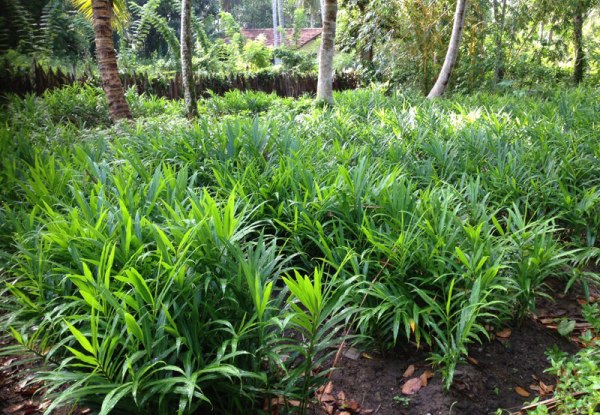
Soil Requirement for Ginger Farming:- Ginger can be grown on wide range of soils. However, it prefers deep, well-drained, friable, loamy soil, rich in organic matter. Try to avoid alkaline soil as ginger crop does not grow well in these types of soils. Crop rotation is very important in ginger farming and do not cultivate ginger in the same field year after year. The recommended soil pH should be between 5.5 and 6.5 for best growth. Having well-drained soil is key factor or success mantra in ginger farming.
Propagation in Ginger Farming:- Ginger is propagated by using portions of mother rhizomes (root cuttings) called as sets. Each healthy set to be used for planting should be 2.5 to 5 cm long, weighing 20 to 25 grams and having 2 or 3 buds each. The seed rhizomes should be treated with Dithane M-45 @ 3 grams per liter of water for 30 to 40 minutes, drained and then should be used for planting.
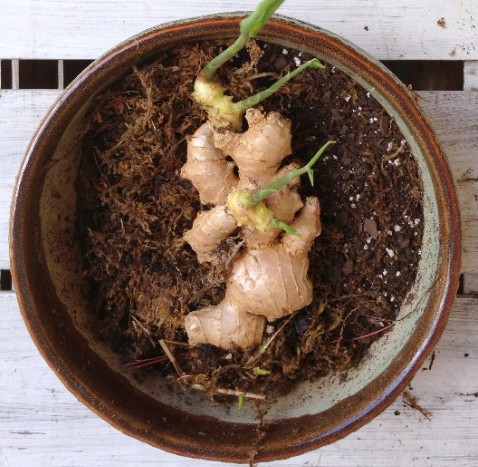
Land Preparation, Planting and Spacing in Ginger Farming:- The land should be ploughed 3 to 4 times thoroughly with receipt of early summer showers to bring the soil to fine tilth. Three to Four crosswise harrowing should be given to make soil loose and friable. Beds of about 1 meter width, 15 cm height and of convenient length should be prepared with an inter-space of 50 cm in between beds. In the case of irrigated crop, ridges are formed 40 cm apart. In areas prone to rhizome rot disease and nematode infestations, solarization of beds for 40 to 45 days using transparent polythene sheets is recommended.15 to 20 tonnes of well decomposed farmyard manure (FMY)/ha should be applied before last harrowing.
Selecting a planting material is important in ginger farming. Healthy rhizomes(root cuttings) free from diseases and pests should be selected. While selecting, make sure rhizomes are broken into pieces keeping 2 to 3 sprouted eye buds on each rhizome. Also make sure that each piece is 2.5 cm to 5 cm long and 20 grams to 25 grams in weight.
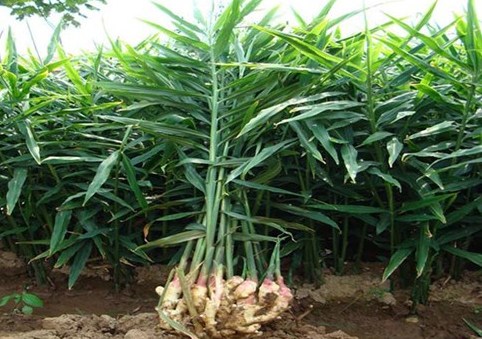
The best time to plant ginger is May to June and seed rate of 1500 to 1600 kg mother root cuttings (rhizomes) is required for one hectare plantation. These rhizomes should be treated with 25 % agallol and Macrotophos for 30 to 40 minutes for control of rhizome fly and treated rhizomes should be stored in trenches prepared under shade. The trenches should be bottoms-lined with dry leaves/straw (mulch). Rhizomes should be spread on this arid are again covered with dried leaves / straw (mulch). This mulching helps to control moisture loss and improves germination percentage. Usually, there will be a weight loss (20 to 30%) in the rhizomes at this point in time.
As part of ginger method of planting, ridges and furrows with 75 cm apart should be used under irrigated condition. For Raised beds the spacing should be 30 cm x 30 cm and hat bed method 25 x 22.5 cm and under new improved method, planting can be done by broad-ridge method ; which is 75 cm broad, 20-30 cm high and 30 cm apart. During planting, the tip of eye buds should face upwards and the rhizomes should be planted at a depth of 5 cm. Out of all, that planting on flat beds proven to be giving better yields.
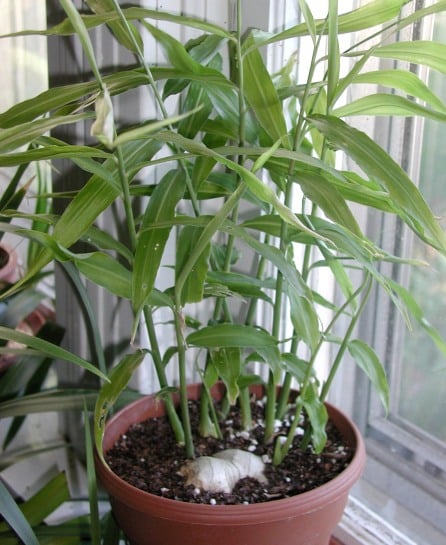
Manures and Fertilizers in Ginger Farming:- The following is the manures and fertilizers schedule in ginger farming.
| S.No. | Application Time | F.Y.M. (tonns/ha) |
N (kg/ha) | P2O5 (kg/ha) |
K20 (kg/ha) |
| 1. | At the time of Land Preparation | 15 | – | – | – |
| 2. | At planting time | 15 | 60 | 50 | 50 |
| 3. | 45 days after planting the roots | – | 50 | – | – |
| 4. | 4 months after planting the roots | – | 40 | – | – |
| Total Required | 30 | 150 | 50 | 50 |
Irrigation in Ginger Farming:- Irrigation should be carried out immediately after planting is done and subsequent irrigations should be given at 8 to 10 days intervals. Total an about 20 irrigations are required throughout the crop. In case of rainfed crop, it requires well-distributed rainfall during the growth period. Drip or Sprinkler irrigation can be opted in ginger farming.
Intercultural operations in Ginger Farming:- The following activities are important in ginger farming.
- Mulching: As part of inter cultural operation, this is very important task to check the weed growth and prevent the soil erosion. Mulch also prevents the water evaporation from the plant base soil. Any dried leaves or straw can be used as a mulching material. This mulch martial will decompose, after some times and be applied as organic matter.
- Shading: For shading purpose, seeds of cluster bean, pigeon pea should be sown in irrigation channels on the corner of raised beds.
- Weeding: Hand weeding should be done during first 2 months to keep the plant base clean and depending upon intensity of weeds, 5 to 7 weeding should be carried to have better yield.
- Earthing -up: The soil around the plants is worked with the help of sharp tool in the first week of September. It helps to break the fibrous roots and thereby supports new growth. The soil near the rhizomes becomes loose and friable and helps in proper development of rhizomes and also helps to grow the ginger roots easily.
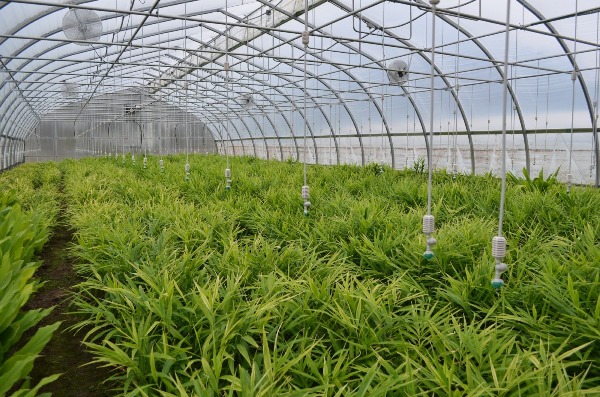
Pests and Diseases in Ginger Farming:-
a) Pests found in Ginger farming:
Shoot Borer:
Symptoms: The symptoms It prepares holes in the pseudo stem. Grass is thrown out of the holes and central shoot becomes yellow and withers.
Control measures:. Spraying 0.1% malathion at monthly interval from July to August will check out this.
Rhizome Flies:
Symptoms: The maggots bore into rhizome and feed on it.
Control measures: Spraying 0.05% methly parathion, 2 to 3 times from July onwards will control this.
Leaf Roller:
Symptoms: The caterpillar feeds from within the leaf by folding it.
Control measures: Spraying of 0.05 % Dimethoate will control this.
Scales:
Symptoms: They suck sap from rhizomes and cause them to shrive and dry up.
Control measures: Dip the rhizomes in 0.05 % dimethoate at planting to control this..
Chinese rose beetle:
Symptoms:”Shot-hole” appearance of leaves; entire leaf consumed with the exception of the leaf veins; adult insect is a reddish-brown beetle which feeds on plants at night.
Control measures: Chinese rose beetles are attracted to dim light and repelled by bright light; shining bright light on plants may help.
b) Diseases found in Ginger Farming:
Soft-Rot:
Symptoms: It is the most destructive disease causing total loss of affected clumps. Light yellowing of tips of lower leaves spreads downwards to leaf blades. It spreads to all leaves of plant and is followed by drooping, withering and drying. Rotting spreads to rhizomes from collar region of stem. Disease spreads from seed, rhizomes and soil.
Control measures: Provide well-drainage, select disease-free rhizomes for sowing, and treat rhizomes with 03 % Dithane M-45 for 30 to 40 minutes before storage and before planting. Finally drench the beds with same fungicide or Captafol @ 0.1 %.
Leaf-Spot:
Symptoms: Small oval or elongated spots with white centre and dark brown margin develop on leaves.
Control measures: Spraying 1 % Bordeaux mixture will check this disease.
Root-knot nematode:
Symptoms: Water soaked lesions on roots; Gallsgon roots which can be up to 3.3 cm (1 in) in diameter but are usually smaller; reduction in plant vigor; yellowing plants which wilt in hot weather.
Control measures: Solarizing soil can reduce nematode populations in the soil and levels of inoculum of many other pathogens.
Bacterial – Wilt:
Symptoms: Mild, dropping and curling of leaf margin of lower leaves is seen which spreads upwards. Plants wilt with pseudo stem showing dark streaks.
Control measures: Spraying streptocycline @ 200 ppm will check this out.
Harvesting and Yield in Ginger Farming:- Harvesting depends on the stage you want to use them. Generally, for green ginger purpose, harvesting should be done in 215 to 220 days after planting the rhizomes. In case of curing ginger, harvesting should be done in 250 to 260 days after planting the rhizomes. Harvesting should be done when the leaves start yellowing and pseudo stem begins to dry. The rhizomes should be lifted with digging fork cleaned-off the roots.
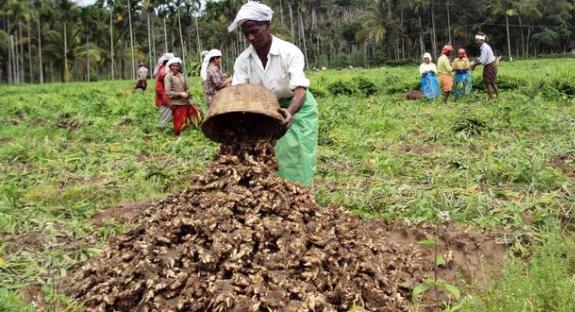
In case of green ginger, 10 to 15 tonnes/ha can be obtained. With good farm management practices cured ginger yield could be 35 to 40 tonnes/ha.
Marketing in Ginger Farming:- The graded and boxed ginger can be transported to local markets or some local traders.
Bottom Line of Ginger Farming:- Farmers can get good profits with ginger farming period.
For Sheep or Goat Farming: Read here.
For Indian Agriculture Information: Read here.

ginger information
Sned me all info of Ginger PDF